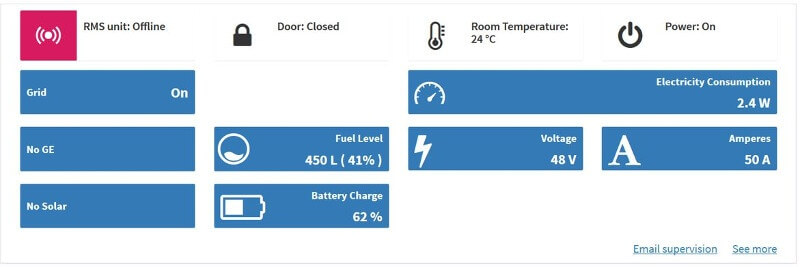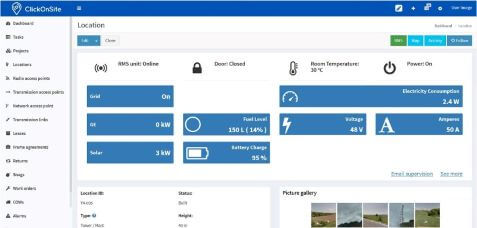IT-Development’s co-founder and Managing Director, Jerome Perret, started his career working for telecoms companies managing tower site rollouts. It is from this hands-on experience of the teams and processes in building and managing towers and assets that he has clear insight to how technology can make work more accurate and efficient for MNOs and Towercos.
Additionally, Jerome talks with customers and prospects every day and hears what they need in the industry and from ClickOnSite. These customer conversations are the #1 inputs for how we prioritize the ClickOnSite features roadmap.
A key philosophy of ITD is that making a single source of information visible across a company greatly enhances efficiency. ClickOnSite achieves this by storing all data and files related to tower sites and assets in one database, available in a couple of clicks to any authorized users in the company (or contractors), from the office to the field.
We extend this philosophy of visibility by building integrations of other services for telecoms with ClickOnSite.
One such new integration built into ClickOnSite is with RMS (Remote Monitoring System) providers. Providing a summary dashboard view of KPIs related to energy and operations at remote tower sites within ClickOnSite makes an additional dimension of information visible, breaking down siloed information in a company and allowing decisions to proactively and efficiently be made.
The ITD team is very enthusiastic about bringing this functionality to our customers through ClickOnSite. As we roll the RMS integration out to customers, I talked to Jerome about it.
Why did ITD decide to integrate RMS services into ClickOnSite?
Jerome Perret: It starts with the guiding vision behind ClickOnsite to make data visible across a company. We are always looking at processes and needs in the industry and how we can serve them either by adding new features to ClickOnSite or by building integrations with other specialists, for example with radio tools (Atoll) and finance (SAP).
With that in mind, we recognized how closely related to ClickOnSite’s value proposition remote monitoring systems are. We also observed the increasing adoption of this new technology in the marketplace.
One of our Towerco clients told me that he is working with different RMS vendors, each with its own, different dashboard. He wanted a unified view across all his dashboards. This is clearly a problem ClickOnSite can solve, so we decided to put ideas into action and build an integration.
What were your first steps?
Jerome Perret: As I said, we have experience with many types of integrations. One of the most popular — and useful — features in ClickOnsite is the integrated Google Maps. We took the concept of Mashup and JavaScript API and did the same with the RMS data.
We then reached out to a number of the leading RMS providers in the telecoms industry to learn requirements from their perspective, and to see if they would like to partner with us in showing RMS KPIs within ClickOnSite’s interface. We convinced three like-minded companies to embark on this adventure with us: Galooli, Cysalys and Asentria.
At both the TowerXchange Meetup Africa & Middle East and the TowerXchange Meetup Asia we met with the team from Galooli to hammer out details, and define a proof of concept. At Mobile World Congress in Barcelona we met and talked with Cysalys and Asentria.
All three companies are great to collaborate with, very open to sharing their specialized know-how to checking/correcting what we have done. And opening their APIs to our development teams in France, Slovakia, and Vietnam so the Proof-of-Concept could be validated.
Who benefits from a ClickOnSite/RMS integration?
Jerome Perret: Kilometers and OPEX are key to our customers. Having accurate, up-to-date information increases efficiency and lowers OPEX. ClickOnSite makes information visible to all departments of an organization so that efficiencies are gained when people in other departments can see and act on information.
Looking from the top down, ClickOnSite helps the following groups in a company:
- Overall company: OPEX savings
- Teams: automates task-assignment with business process management (BPM) and shares information among teams, no matter where they are
- Individuals: puts actionable information at their fingertips to make decisions, for example, capacity planning, which you can do better yourself if you have the info you need
Having RMS KPIs integrated into the ClickOnSite dashboard benefits rollout/site management by serving them valuable information that they don’t have today. And it benefits people from the Run/Supervision group by surfacing information, and real-time issues, allowing them to be addressed without duplication of efforts. For example: if you know that a generator needs to be re-started, a person already on-site can restart the generator, rather than send a different person out to do that one task.

In practice how is this used in ClickOnSite?
Jerome Perret: From the ClickOnSite perspective, there are generally two types of consumers of RMS information:
- Those who monitor the network.
- This group wants to know tons of details, for example, they want to know the fault places. This is a relatively small group of people in the company.
- The staff who deal with site operations.
- This is a large group of people, but they only need some basic RMS KPIs to make their decisions.
One example of the benefit of RMS is the reconciliation of equipment and assets. Companies need to be able to compare the stored data versus the actual state on-premise. ClickOnSite’s central database stores all the information about the equipment at each site. However, the RMS system might say there is no generator at a location. Inventory is thus double-checked and reconciled in two places: ClickOnSite + the RMS reading.
Another example is that if you want to add equipment at a site, RMS tells you the amount of energy you use versus how much you produce. In real-time, you can see your capacity to upgrade without needing to search in files.
A third example is the ability to cross silos in an organization from having information visible across groups: a person out in the field can see if there is an issue that he/she can take care of while nearby, or a person in the office can send one person to take care of a couple (or few) items, rather than multiple people.
The ClickOnSite interface is easily usable by anyone, even in the field, and there is no need to log in to a separate system to see the top-level information.
Might ITD create its own RMS system?
Jerome Perret: ITD has no desire to be an RMS provider ourselves because there are already RMS experts and it is better to integrate and collaborate with them. They have their expertise, we have ours: the #1 platform for the site, task, and asset management. It is better we collaborate to bring expertise and value to clients than cannibalize each other’s business.
What’s next?
Jerome Perret: The RMS dashboard interface has been built for ClickOnSite and we are showing it to customers and prospects. The reactions have all been positive!
Next is to roll out the service to our current ClickOnSite customers, and offer it to prospects. And welcome more RMS vendors to our ecosystem.
Conclusion
Jerome Perret: In today’s workplace, people tend to be overwhelmed with data. Distilling that to getting the right actionable data to the right people at the right time is the key to efficiency. ClickOnSite does that, and new integrations such as with RMS data make it even better for users. We look forward to getting this out in the marketplace!
I would particularly like to thank the teams at Galooli, Cysalys, and Asentria for their great collaboration in making this work.
To learn more about ClickOnSite and our RMS integrations, contact us for a demo.
#MakeTheEverydayBetter
—
About ITD/ClickOnSite: ClickOnSite provides Mobile Network Operators (MNOs) and Towercos an innovative end-to-end solution to lower costs and efficiently manage tower sites, rollouts, assets and operations. With ClickOnSite, everyone in the company, from the field to the main office, works on one set of data, in real-time. www.it-development.com
About Galooli: Power operated industries are prone to high operational expenses which can reach up to millions of dollars a year. GalooliPOWER arms telecom operations, data centers, generator manufacturers, mining operations and more with a comprehensive solution that translates data into AI-driven insights for smarter and more efficient asset management. www.galooli.com
About Cysalys: Cysalys reduces the energy cost of telecom operators by providing hybrid, connected, smart power solutions. We do this by using our own all-in-one combined power unit (solar/batteries/genset), or optimizing our customers’ energy sources by integrating our smart EMS to them. Our solutions are all connected to our RMS, allowing to supervise the energy production and control our systems remotely as well as capturing all relevant data. And because we know that every site and situation is different, our systems are entirely customizable to fit the needs of any conditions. Reliability, cost effectiveness and adaptability. www.cysalys.com
About Asentria: Asentria Corporation enables telecom operators to run more reliable and cost-effective networks by providing cell site automation solutions for managing power, security, and environmental issues at remote sites. Asentria integrates generators, rectifiers, door-access controllers, cameras, HVAC, and other systems into our SiteBoss appliance to present a single management interface. The SiteBoss enables automation of key functions to reduce energy, maintenance, and service costs and extend site life during crisis conditions. www.asentria.com
